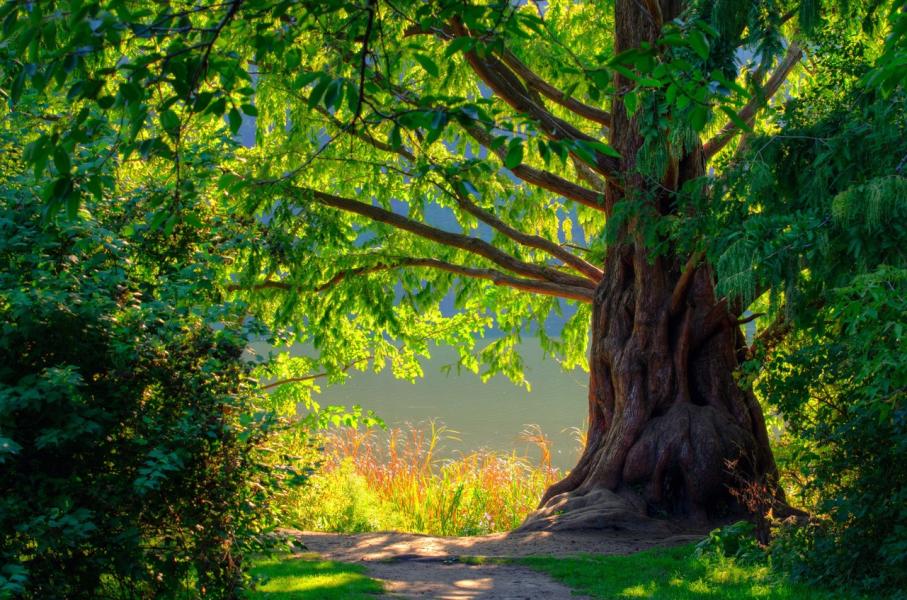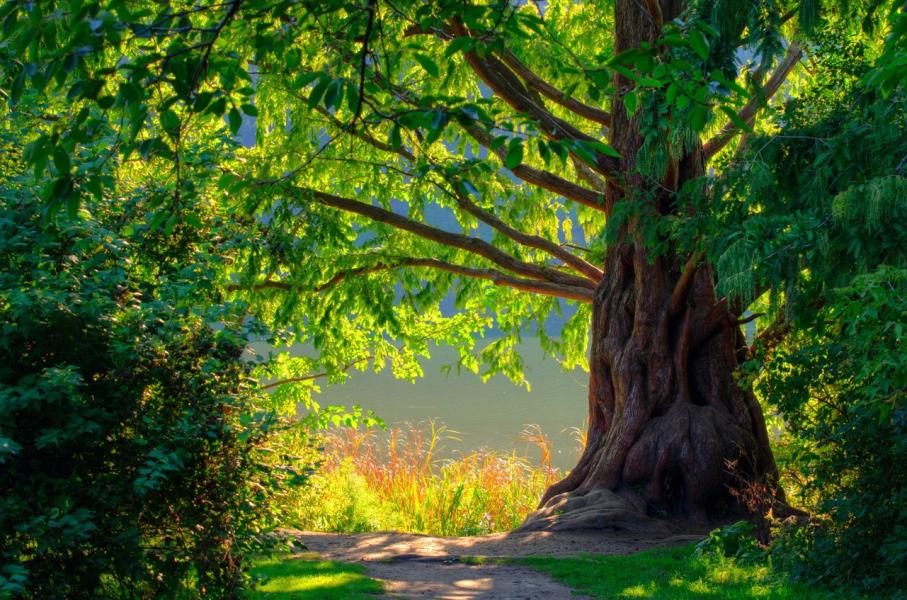High Park is a 161-hectare urban park that is located just west of downtown Toronto and managed by the City of Toronto. Declared an Area of Natural and Scientific interest in 1989, High Park has many habitats that are rare in southern Ontario, and is home to a high degree of floral and faunal biodiversity. However, High Park is also one of the most heavily used and impacted parks in the province. It features a variety of recreational amenities, including roads, hiking trails, picnic areas, sports facilities, children’s playgrounds, restaurants, and several manicured gardens, as well as a swimming pool, dog off-leash park, nature center, zoo, amphitheater, and a collection of Japanese cherry trees.
High Park’s physical location was once on the shoreline and beach of glacial Lake Iroquois, whose wave action deposited large amounts of the sand and created the sandy soils that are present today. As the shoreline gradually shifted south, the Spring and Wendigos Creek, which flows through High Park, cut deep ravines into sand deposits. The remnants of high sand bars also retain water flow, creating the various ponds that are present in High Park, including Grenadier and Duck Pond. The margins of these ponds are marshy and populated with sedges, cattails, sweet flag, arrowhead, blue flag iris, Joe Pye weed, and bulrushes.
The sand plains of High Park support pockets of oak woodland and savannah ecosystems. These ecosystems consist of widely spaced black oak trees interspersed with sassafras groves, white oak, red oak and burr oak, and bushes such as northern bush honeysuckle, roses, northern dewberry, and New Jersey tea. Importantly, because the trees do not grow densely together, there is a lot of sunlight available under the canopy and on the forest floor. This allows prairie species such as wild lupines, cup plants, sunflowers, harebells, black eyed Susan, goldenrods and asters, and grasses such as big bluestem, Canada wild rye, and bottlebrush grass to flourish. Oak savannahs used to be widespread in the Great Lakes region, but now less than 0.01% of the savannahs that existed prior to European colonization remain.
High Park is also located at the convergence of the Carolinian forest type, which predominate in the south, and the Great Lakes-St. Lawrence Forest type, which is typical north of Toronto. The moist ravines of High Park are home to diverse types of deciduous and mixed forests. Common trees in the ravine include red oak, black cherry, white ash, white birch, Norway maple and slippery elm. Common shrubs include chokecherry, nannyberry, buckthorn, alternate-leaved dogwood, hawthorn; vines include American bittersweet, Virginia creeper, grapevine and gooseberries. Woodland herbaceous plants such as false Solomon’s seal, sarsaparilla, woodland sedges, large-leaved aster, Canada mayflower and raspberries grow in the understory.
High Park has a history of Indigenous habitation whose material records archaeologists date back to 7000 BCE. Located to the east of the Humber River, it is close to the Toronto Carrying Place, which was a widely used travel and trade route connecting Lake Ontario to Lake Simcoe. A series of smaller Indigenous trails also existed within the boundaries of present-day High Park. These trails were located along the ridges of ravines so that travelers could avoid low-lying wet places.
The black oak savannah ecosystems within High Park are 4000 years old and were stewarded and maintained by Indigenous inhabitants through cultural burning. The original peoples of the the area set fire to the landscape using a controlled, seasonal technique that opened the forest canopy and encouraged the growth of food-producing plants, such as fruit and nut trees and shrubs. The open landscape of the savannah also eased wildlife and human movement, making it good for hunting.
There are estimated to be up to 57 Indigenous archaeological sites and burial mounds located in High Park. These include a series of graves on a sandy ridge located north of Grenadier Pond, which date from 2500 BCE to 800 CE, including Snake Mound, Bear Bound, and a 19th-century Mississauga village and burial place. Snake Mound is located at the southeastern corner of High Park, and according to Iroquoian oral history shared by the Taiaiako’n Historical Preservation Society, the mound is 3000 years old. For many years, Snake Mound was unmarked and was often used by bikers, who damaged the mounds. The Taiaiako’n Historical Preservation Society advocated for the protection of Snake Mound, and in 2009, a Stage 1 and 2 archaeological assessment was conducted at the site. The archaeological assessment did not find archaeological resources at the Snake Mound site; however, members of the Taiaiako’n Historical Preservation Society maintain through culturally-grounded knowledge that various materials found in Snake Mound, including obsidian, mica, white clay, and marine animal shells, were common grave goods that were traded by Indigenous peoples along long-distance trade routes. High Park staff eventually fenced off Snake Mound to cyclists, and replanted the mound with native plants.
During the late 1600s, High Park was frequented by the inhabitants of the Iroquoian/Haudenosaunee (Seneca and Mohawk) village of Teiaiagon, who continued traditions of clearing the land with fire, and cultivating agricultural fields in the sandy upland area. The Bear Mound, which is a burial mound located north of present-day Grenadier restaurant, was constructed by the Seneca. After the Haudenosaunee moved away from Teiaiagon, south to the Grand River and Niagara watersheds and their homelands east of Lake Erie and South of Lake Ontario, the Humber River Valley and High Park areas were inhabited by the Mississaugas of the Credit First Nations throughout the 1700s and early 1800s. A Mississauga village and burial site from this period was excavated just outside of the present-day borders of High Park
In 1787, land north of Lake Ontario in the area of the present-day Greater Toronto Area was transferred from the Mississaugas of the Credit First Nation to the British crown as part of the Toronto purchase. Subsequently, the Toronto area was heavily settled by European immigrants, and not much later, immigrants from diverse areas of the world. During the 1800s, fire suppression, agricultural transition, and the introduction of new diseases and plant species greatly reduced the extent of savannah ecosystems in the area.
The current land base of High Park was purchased by John Howard, who was an architect and land surveyor, and his wife Jemima Howard, in 1836. They named the property High Park because it was on high ground overlooking the lake. Howard designed and built a country house on the property, which is preserved as the Colborne lodge. 1873, the Howards deeded the property to the City of Toronto as a "Public Park for the free use benefit and enjoyment of the citizens of the City of Toronto forever," and included the condition that the property must be left in its natural state.
The initial development of the park, which included actions such as cutting down trees, laying down concrete and asphalt, and creating turf lawns, resulted in the continued ecological degradation of the park. Beginning in the late 1900s, efforts were made to restore the ecological integrity of High Park. These practices include the re-introduction of prescribed fires to the park. However, the prescribed burns that occur in High Park are carried out by City of Toronto workers and have excluded Indigenous representation and traditional knowledge of cultural burning.
The Indigenous Land Stewardship Circle, an organization composing of elders, knowledge keepers and community members of many First Nations, including the Haudenosaunee, Anishinaabe, Wendat and Métis, are working with the urban forestry department in the City of Toronto to bring Indigenous stewardship back to High Park. Recently, the City has begun to make space for Indigenous peoples to carry out traditional practices in High Park. This includes creating space for growing medicines and three sisters’ gardens. The Indigenous Land Stewardship Circle has also launched the turtle protector program. As part of this program, volunteers who are guided by Indigenous knowledge principles, engage in the protection and conservation of turtles in High Park. In 2019, the Indigenous Land Stewardship Circle called for a ban on pesticides in High Park.
Black Oak Savannah and Woodlands in High Park: https://highparknature.org/article/black-oak-savannah-and-woodlands-in-high-park/
High Park Toronto home page: High Park Toronto
High Park Nature website: Discover the natural wonders of High Park - High Park Nature
The Indigenous History of Tkaronto: https://guides.library.utoronto.ca/Toronto
Indigenous Land Stewardship Circle: Healing Land and Community in Tkaronto: Indigenous Land Stewardship Circle | Healing land and community in Tkaronto (wordpress.com)
Taiaiako’n Historical Preservation Society: Protecting High Park Burial Mounds: Taiaiako'n Historical Preservation society – protecting High Park Burial Mounds (wordpress.com)
Turtle Protectors, Mishiikenh Gizhaasowin: Turtle Protectors – We advocate, support and protect our Turtle relatives living within High Park while embracing all of our kin!
| English | Latin | Kanienʼkéha | Anishinaabemowin |
|---|---|---|---|
| Common Milkweed | Asclepias syriaca | otshehón:ta, kanon’tínekenhs, tsitsenetse, otshehwèn:ta, kanon’tínekenhs | ninwish, aniniwish |
| White Ash | Fraxinus Americana | káneren | aagimaak, bwoyaak |
| Green Ash | Fraxinus pennsylvanica | kaneróhon | emikwaansaak, aagimaak, bwoyaak |
| Spreading Dogbane | Apocynum androsaemifolium | wahseriye'tonnyà:tha, skatsí:wa'k | sasa'bikwan, ma'kwona'gicobji'bik |
| Wild Sarsaparilla | Aralia nudicaulis | tsyotere'se'kó:wa, yonekó:wa, tsyawenséhsha, otsyawénhsa | waaboos-odji-bik, waabooz jiibik |
| Burdock | Arctium lappa | ohrohte’kó:wa | zagdebwe, zadebwe |
| Common Milkweed | Asclepias syriaca | otshehón:ta, kanon’tínekenhs, tsitsenetse, otshehwèn:ta, kanon’tínekenhs | ninwish, aniniwish |
| Paper birch | Betula papyrifera | watenakè:taron's, watenakè:taronhs | wiigwas (singular), wiigwaasaatig (plural), wiigwaasi-mitig |
| Alternate-leaf Dogwood | Cornus alternifolia | teyotsí:tsayen | moozwemizh, moozomizh, niibiishan miskwaabiimizhiig |
| Gray Dogwood | Cornus racemosa | tsítyete | mazh’omizh |
| Large-leaved Aster | Eurybia macrophylla | teyonerahtawe'éhston, orón:ya yotiron’onhkóhare, iotsiron'onhkóhare oròn:ia, yako’tonhkwárhos onónhkwa, iako'tonhkwáhrhos onónhkwa | migiziwibag |
| White Ash | Fraxinus Americana | káneren | aagimaak, bwoyaak |
| Green Ash | Fraxinus pennsylvanica | kaneróhon | emikwaansaak, aagimaak, bwoyaak |
| False Solomon’s Seal | Maianthemum racemosum | kítkit o'éta | agongseminan, agongosimizh, agong’osiminan |
| Common Yellow Woodsorrel | Oxalis stricta | teyoratu teyorá:ton | ziiwanabagashk |
| Virginia Creeper | Parthenocissus quinquefolia | kontiráthens | mnidoo- biimaakwad bebaamooded |
| Common plantain | Plantago major | atenhnéha, teyohahó:ron | onaanigizidaanbag (-oon, plural), ginebigowashk, mashkiigobag, omakakiibag |
| Black Cherry | Prunus serotina | é:ri, e:ri’kó:wa, tyotyò:ren | ookweminagaawanzh, ookweminan, ikwe'mic |
| Chokecherry | Prunus virginiana | tyakonya’tawén:’eks, teyakonya’tawén:’eks | asasaweminagaawanzh, asasaweminan, baakinminaan, asasaweminogaawangh |
| Red Oak | Quercus rubra | karíhton | miskode-miizhmizh, mitig mewish (-iik plural) |
| Allegheny Blackberry | Rubus allegheniensis | sá:yase | odatagaagominag |
| Common Dewberry | Rubus flagellaris | sá:yase | odatagaagominag |
| Red Raspberry | Rubus idaeus | skanekwen’terá:yen, skanekwen’terá:ne, skanekwenhtará:nenh | miskomin (-ak, plural) |
| Purple Flowering Raspberry | Rubus odoratus | ahtahkwakáyu, ahtahkwaká:yon | miskomin (-ak, plural) |
| Canada Goldenrod | Solidago canadensis | otsí:nekwar niyotsi’tsyò:ten | ajidamoowaanow, waabanoominens/waabanoominensag, giizisso mashkiaki |
| New England Aster | Symphyotrichum novae-angliae | teyonerahtawe'éhston, yotsiron’onhkóhare orón:ya | waanisikensiwang |
| Dandelion | Taraxacum officinale | tekaronhyaká:nere | mindemoyanag, doodooshaaboojiibik, mindimooyenh, wezaawaaskwaneg |
| Poison Ivy | Toxicodendron radicans | yakohón:taras, yakohontaráhstha, wate’nenharì:sere, yakohén:tara’s | nimkiibak |
| Slippery Elm | Ulmus rubra | akará:tsi | ozhaashigob |
| Nannyberry | Viburnum lentago | kaya (?) tará:kwi | (check this) |
| Wild Grape | Vitis riparia | o’nénhare | zhoominan, jo’minaga’wanj |

